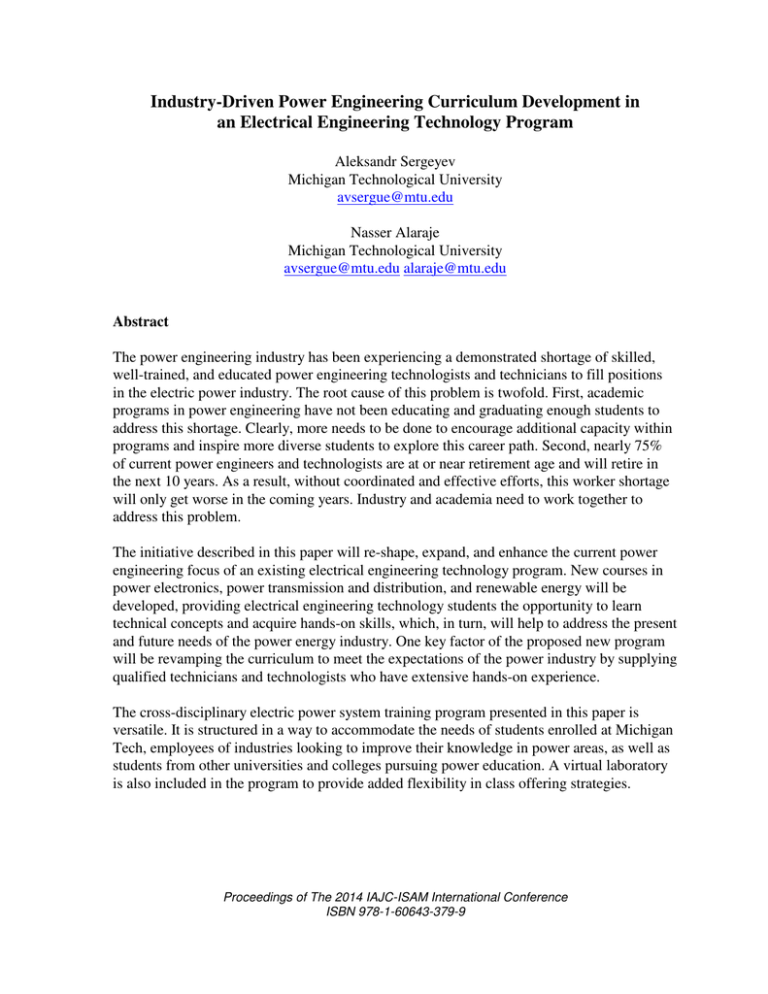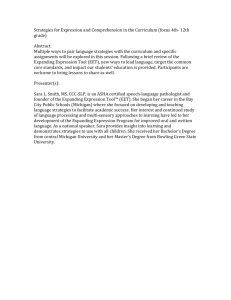Industry-Driven Power Engineering Curriculum Development in an
advertisement

Industry-Driven Power Engineering Curriculum Development in an Electrical Engineering Technology Program Aleksandr Sergeyev Michigan Technological University avsergue@mtu.edu Nasser Alaraje Michigan Technological University avsergue@mtu.edu alaraje@mtu.edu Abstract The power engineering industry has been experiencing a demonstrated shortage of skilled, well-trained, and educated power engineering technologists and technicians to fill positions in the electric power industry. The root cause of this problem is twofold. First, academic programs in power engineering have not been educating and graduating enough students to address this shortage. Clearly, more needs to be done to encourage additional capacity within programs and inspire more diverse students to explore this career path. Second, nearly 75% of current power engineers and technologists are at or near retirement age and will retire in the next 10 years. As a result, without coordinated and effective efforts, this worker shortage will only get worse in the coming years. Industry and academia need to work together to address this problem. The initiative described in this paper will re-shape, expand, and enhance the current power engineering focus of an existing electrical engineering technology program. New courses in power electronics, power transmission and distribution, and renewable energy will be developed, providing electrical engineering technology students the opportunity to learn technical concepts and acquire hands-on skills, which, in turn, will help to address the present and future needs of the power energy industry. One key factor of the proposed new program will be revamping the curriculum to meet the expectations of the power industry by supplying qualified technicians and technologists who have extensive hands-on experience. The cross-disciplinary electric power system training program presented in this paper is versatile. It is structured in a way to accommodate the needs of students enrolled at Michigan Tech, employees of industries looking to improve their knowledge in power areas, as well as students from other universities and colleges pursuing power education. A virtual laboratory is also included in the program to provide added flexibility in class offering strategies. Proceedings of The 2014 IAJC-ISAM International Conference ISBN 978-1-60643-379-9 Introduction The power engineering industry has been experiencing a demonstrated shortage of skilled, well-trained, and educated power engineering technologists and technicians to fill positions in the electric power industry. The root cause of this problem is twofold. First, academic programs in power engineering have not been educating and graduating enough students to address this shortage. Clearly, more efforts are required to encourage additional capacity within educational programs and inspire more and more diverse students to explore this career path. Second, nearly 75% of current power engineers and technologists are at or near the retirement age and will retire in the next 10 years. As a result, without coordinated and effective efforts, this worker shortage will only get worse in the coming years. Industry and academia need to work together to address this problem. Many electrical engineering technology programs have already started revamping their power engineering curriculum to address the shortage of skilled technologists in the power energy industry by introducing courses in power electronics and renewable energy. For example, Texas A&M University is developing a new program in power engineering technology with a focus on the nuclear power industry [1]. A new nuclear power institute was formed in collaboration with community colleges to enhance both two-year and four-year technology programs relevant to the power industry. The new program is multidisciplinary, with the aim of training the next power engineering technologist workforce. At the University of Cincinnati, the Electrical and Computer Engineering Technology Department has developed a new two-year associate degree in power system engineering technology. The program started in fall 2006 with 10 students; efforts are currently underway to extend the two-year degree into a four-year baccalaureate degree [2]. At the University of Houston, efforts are underway to reverse the traditional low enrollment of students in the electrical technology program. There, a new electrical power technology program was started in fall 2003 and, since the program began, enrollment has increased steadily from 60 students (in the previous electrical technology program) in fall 2002, to 91 students in fall 2003, and 109 students in fall 2004. The new electrical power technology program curriculum covers topics in power generation, power transmission and distribution, electrical machinery and machine control, electrical system design, and industry practice [3]. At the State University of New York, Buffalo, a power/machines option in the electrical engineering technology program has undergone major changes in order to enhance the program and meet power industry expectations. The new curriculum offers topics in power systems, electric machines, and power electronics [4]. The Electrical Engineering Technology (EET) program at Michigan Tech is ready to take the challenge and collaborate with local and regional industry to develop a power engineering curriculum to help solve the current shortage and future expected growth in power engineering professionals within the state and beyond. The EET program will develop and expand its current power focus area to train a larger and more diverse future power engineering technologist workforce that will meet the changing needs of the industry. Proceedings of The 2014 IAJC-ISAM International Conference ISBN 978-1-60643-379-9 University Overview Michigan Tech is a public university committed to providing a quality education in engineering, science, business, technology, communication, and forestry. In fall 2013, total enrollment was 6,979 students, including 1,333 (19.1%) graduate students. Over 65% of Michigan Tech students are enrolled in engineering and technology programs [5]. The School of Technology offers programs covering the entire spectrum of technology. The School of Technology awards bachelor’s degrees in computer network & system administration, construction management, electrical engineering technology, mechanical engineering technology, and surveying engineering. The EET program at Michigan Tech offers a Bachelor of Science in Electrical Engineering Technology. The program is applications-oriented and focuses on preparing graduates for entry into the workforce upon graduation, with career options in microcontroller applications, robotics, industrial automation, instrumentation, and control. The University Curriculum Content Recognizing the need for the next generation of skilled technologists for power engineering fields, the EET program at Michigan Tech will re-shape, enhance, and expand its power engineering focus area. The power engineering curriculum development will incorporate the addition of three new courses that will be added to the current two courses, electrical machinery, and power systems. The EET program will re-shape the current power systems course to focus on power distribution and introduce three new courses (power transmission, power electronics, and alternative energy sources). Figure 1 shows the current and proposed power engineering focus area curriculum; descriptions of the three new courses are provided below. We were able to add three new courses without affecting the overall degree plan. The current EET program has a shortage of courses in power engineering; only one course (power systems) is currently offered. The EET program will still be structured as a 127-credit hour program with 68 credits of technical courses in EET, which aligns with ABET requirements [6]. Summary of Courses EET 3390 Power Distribution is a three-credit hour course that introduces electrical power distribution. Fundamental concepts for modeling distribution lines, power system generators, power transformers, three-phase power, line faults, distribution system protection, and power system load are thoroughly covered. A simulation of power systems during normal and abnormal conditions is presented. Proceedings of The 2014 IAJC-ISAM International Conference ISBN 978-1-60643-379-9 Figure 1. Current and proposed power engineering curriculum EET 4390 Power Transmission is a three-credit hour course that provides an overview of transmission systems. Topics such as transmission voltage levels, requirements for overall system stability, transmission line parameters, line faults and protection, and bulk power substations are discussed in-depth. Fundamentals of line construction and planning are also covered. EET4391 Power Electronics is a four-credit hour course that presents an introduction to electronic power conversion circuits. It provides an analysis of basic switching circuits and power converter topologies including DC/DC converters, AC/DC rectifiers, DC/AC inverters, and AC/AC frequency converters. It discusses the selection criteria for reactive elements and models of solid-state switching devices and identifies common performance objectives such as efficiency and power factor. EET 4393 Alternative Energy Sources is a three-credit hour course that presents an overview of the world’s energy resources and energy consumption trends. Conventional and emerging energy sources and conversion methods are discussed in terms of their long term viability, based on technical and political factors. Major types of renewable energy sources are discussed in the course in detail. Relevant topics on energy transport and its technologies, and system perspectives on energy transports are also presented in the course. “PowerWorld” Simulation Software: Students’ theoretical knowledge will be enhanced by PowerWorld software, which is commonly used in the power industry. This software will Proceedings of The 2014 IAJC-ISAM International Conference ISBN 978-1-60643-379-9 also serve the purpose of providing extensive hands-on experience in the laboratories. The PowerWorld Simulator is an interactive power systems simulation package designed to simulate high voltage power system operation over periods ranging from several minutes to several days. The software contains a highly effective power flow analysis package capable of efficiently solving system operations. PowerWorld Simulator 14, the most recent power system simulation software package, is licensed for educational use and available from PowerWorld Corporation to educational institutions at no cost. Laboratories Currently, there is no laboratory component in the Power Systems course; however, the students receive hands-on training through field trips to local power plants and paper mills. A laboratory component will be an integral part of all three courses. The university will obtain necessary laboratory equipment by seeking external funds and via donations from industry. A selection of educational and training laboratory equipment that can be used to teach hands-on techniques in all the classes described above is available from US Didactic, Inc. [7] Laboratory exercises will be developed to provide students with extensive hands-on experience valuable to the industry. Because most of the electrical power is produced by generators (this applies to power stations as well as to standby power supplies), hydroelectric, and wind generators, the students will be provided with hands-on experience related to threephase synchronous generator experiments. In addition to basic experiments dealing with three-phase synchronous generators, EUG modulus [7] involving manual and automatic synchronizing circuits, the automatic power factor and power control will be developed. The EUG modules will be used to simulate power station operation in stand-alone (isolated) or interconnected operations. By adding EUL Power Transmission Line modules [7], the three-phase line simulation of a high voltage overhead power line for measuring various operational states (open-line, matched, shortcircuit) will be demonstrated. In addition, EPP_SYS renewable and conventional power plants [7] with transmission and distribution systems will be utilized to design and teach laboratories in The new courses. Power plants include synchronous generators, double-fed asynchronous generator with WindSim software, and photovoltaic station. These educational training platforms will allow the faculty member to cover a wide variety of relevant to the subject topics and provide significant hands-on experience in topics related to manually operated synchronizing circuits, automatic synchronizing circuits, automatic power factor control, three-phase lines, generator protection, energy consumption, relays, busbars, and load monitor. ET 850 Steam Generator and ET 851 Steam Turbine Modules [7] will be utilized in EET 2233, EET 3390. The broad spectrum of topics such as the efficiency of a steam generator, the effect of the air feed of the exhaust gas, setting up energy balances, determining the temperature and pressure of saturated steam, determination of steam enthalpy, the heat transfer coefficient, specific steam consumption of the turbine, turbine power for different Proceedings of The 2014 IAJC-ISAM International Conference ISBN 978-1-60643-379-9 pressures of live and exhaust steam, and thermal and overall efficiencies will be calculated using this equipment. The EPE SERIES Power Electronics and Machine Drive equipment [7] will support the laboratory component of EET 4391 and introduce fundamental concepts involving singlequadrant and four-quadrant controllers, single- and three-phase power inverters, AC controllers/three-phase controllers, switched mode power supplies, pulse width modulation PWM, power semiconductors, uncontrolled and controlled rectifiers, automatic control, and speed adjustment. Implementation of the virtual laboratories is a program long term goal. Online material will be recorded and posted on a dedicated website with access permission provided to registered students. Virtual laboratories will be conducted over the Internet in real time. The lab assistant physically present in the laboratory and having the access to the equipment will communicate with and assist students in assembling various circuits and completing the laboratory assignment. The lab assistant will be the student’s hands. Virtual labs not only provide an effective way of conducting laboratory exercises for a broader range of students registered for the class on-campus or off-campus but also enable training of industry workers without them leaving their place of employment. Training Plan for Students and Industry Representatives The cross-disciplinary electric power system training program at Michigan Tech is intended to be very versatile. It is structured to accommodate the needs of the Michigan Tech students, industry employees looking to improve their knowledge in power areas, as well as students from other universities and colleges pursuing power education and electing to take online courses on power transmission, distribution, alternative energy, and power electronics. In addition, course materials developed through this initiative will be disseminated to increase the impact of engineering technology programs at other institutions. The overall training plan for students and industry representatives is outlined in Figure 2. Current Michigan Tech students seeking a degree in power will have two choices for completing requirements: Path 1: Students will register for semester on-site courses and laboratories. Both the courses and the laboratories will be taught in real time by faculty and lab assistants. Path 2: Students will register for semester online courses with the intensive, one-week-long, on-site laboratories. Online material will be recorded and posted on a specifically designed website with access for registered students. One week on-site laboratories will be conducted by the faculty and lab assistants in real time. Proceedings of The 2014 IAJC-ISAM International Conference ISBN 978-1-60643-379-9 Figure 2. The proposed cross-disciplinary electric power training program at Michigan Tech Industry employees looking to improve their knowledge in the power area, as well as students from other universities and colleges pursuing power education may select one of three choices: Path 1: Students will register for the semester on-site courses and laboratories. Both the course and the laboratories will be taught in real time by faculty and lab assistants. Path 2: Students will register for semester online courses with intense, one-week-long, onsite laboratories. Online material will be recorded and posted on a specifically designed website with access for registered students. One-week, on-site laboratories will be conducted by the faculty and lab assistants in real time. Proceedings of The 2014 IAJC-ISAM International Conference ISBN 978-1-60643-379-9 Path 3: Students will register for semester online courses with virtual laboratories. Online material will be recorded and posted on a specifically designed website with access for registered students. Virtual laboratories will be conducted over the Internet in real time. The lab assistant will be physically present in the laboratory, have access to the equipment, and communicate with and assist students in assembling the circuit and completing the laboratory assignment. The lab assistant will serve the purpose of being the student’s hands in real time, enabled by online learning software. Due to rapid changes in the technological world, faculty involved in teaching must keep informed of advances in technology currently used in the industry. On the other hand, industry wants to have qualified and well-educated employees who are ready to implement their knowledge on day one of their employment. As a result, while academia needs to be fully aware of the current knowledge requirements, industry must be driving curriculum development. We intend to strengthen an existing link between the university and industry in order to stay current. We intend to stay current regarding industry needs by communicating with local power plants and paper mills, collecting relevant information from industrial advisory board members, and by attending professional meetings. This type of partnership is a two-way street and advantageous for both parties. Conclusion Academic programs in the School of Technology at Michigan Tech are designed to prepare technical and/or management-oriented professionals for employment in industry, education, government, and business. This curriculum development will reshape, enhance, and expand the power engineering focus area in EET programs, beginning at Michigan Tech. Curriculum revision will provide EET students with the opportunity to learn concepts and hands-on skills and will address the present and future needs of the power energy industry. The curriculum revision will provide a model for other EET programs, and resources developed will be made available to others. The primary outcome of this initiative will be a larger number of better qualified engineering technology graduates with skills and knowledge that are current and relevant. References [1] [2] [3] [4] Porter, J., Zhan, W., Alvarado, J., & Morgan, J. (2008). Power Engineering Technology: A New Program Targeted at the Nuclear Power Industry. Proceedings of the ASEE Annual Conference. Paper #487. Miller, R., Rabiee, M., & Stepp, E. (2008). Power Engineering Technology Program Development. Proceedings of the ASEE Annual Conference. Paper# 614. Faulkenberry, L. & Shireen, W. (2006). Evolution of the Electrical Power Technology Program at the University of Houston. Proceedings of the ASEE Annual Conference. Paper #1195. Grinberg, I. (2001). Power Systems Curriculum and Course Structure in Electrical Engineering Technology Program. Proceedings of the ASEE Annual Conference. Paper #782. Proceedings of The 2014 IAJC-ISAM International Conference ISBN 978-1-60643-379-9 [5] [6] [7] Michigan Technological University Admission Office. (n.d.). Retrieved from http://www.mtu.edu/admissions/ Criteria for Accrediting Engineering Technology Programs . (2007). Baltimore, MD: Technology Accreditation Commission, ABET, Inc. US Didactic, Inc. (2003). Retrieved from http://www.usdidactic.com/ Biographies ALEKSANDR SERGEYEV is currently an associate professor in the Electrical Engineering Technology program in the School of Technology at Michigan Tech. Dr. Sergeyev earned his bachelor degree in Electrical Engineering at Moscow University of Electronics and Automation in 1995. He obtained the master’s degree in Physics from Michigan Tech in 2004 and the PhD degree in Electrical Engineering from Michigan Tech in 2007. Dr. Sergeyev’s research interests include high-energy laser propagation through the turbulent atmosphere, developing advanced control algorithms for wavefront sensing and mitigating effects of the turbulent atmosphere, digital inline holography, digital signal processing, and laser spectroscopy. Dr. Sergeyev is a member of ASEE, IEEE, SPIE and is actively involved in promoting engineering education. Dr. Sergeyev can be reached at avsergue@mtu.edu. NASSER ALARAJE is currently the Electrical Engineering Technology program chair, as well as a faculty member at Michigan Tech. He taught and developed courses in the computer engineering technology area at the University of Cincinnati and Michigan Tech. Alaraje’s research interests focuses on processor architecture, system-on-chip design methodology, field-programmable logic array architecture and design methodology, engineering technology education, and hardware description language modeling. Dr. Alaraje is a Fulbright scholar; he is a member of the American Society for Engineering Education , a member of the ASEE Electrical and Computer Engineering Division, a member of the ASEE Engineering Technology Division, a member of the Institute of Electrical & Electronic Engineers, and a member of the Electrical and Computer Engineering Technology Department Heads Association. Dr. Alaraje can be reached at alaraje@mtu.edu. Proceedings of The 2014 IAJC-ISAM International Conference ISBN 978-1-60643-379-9


